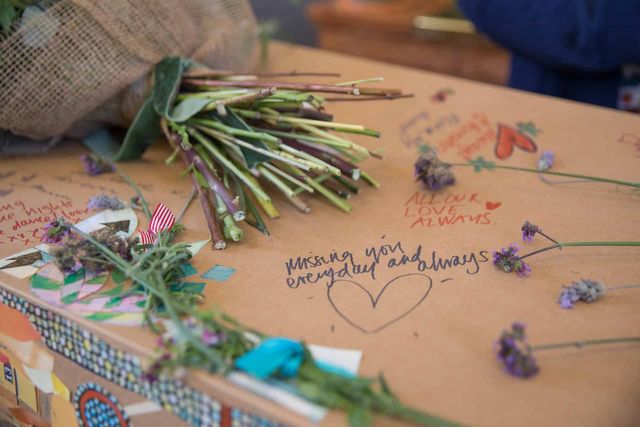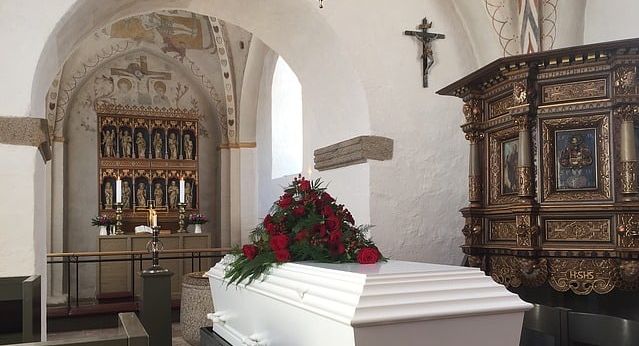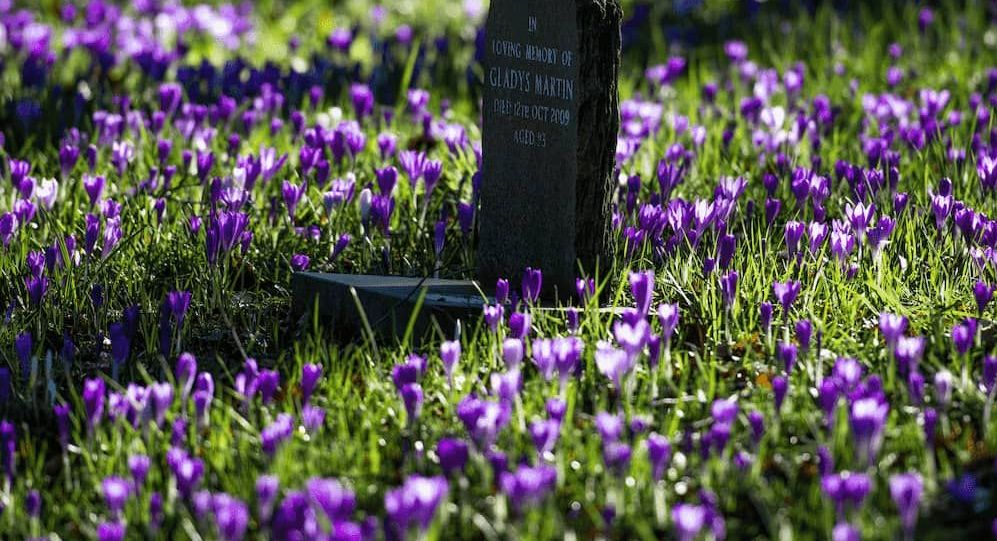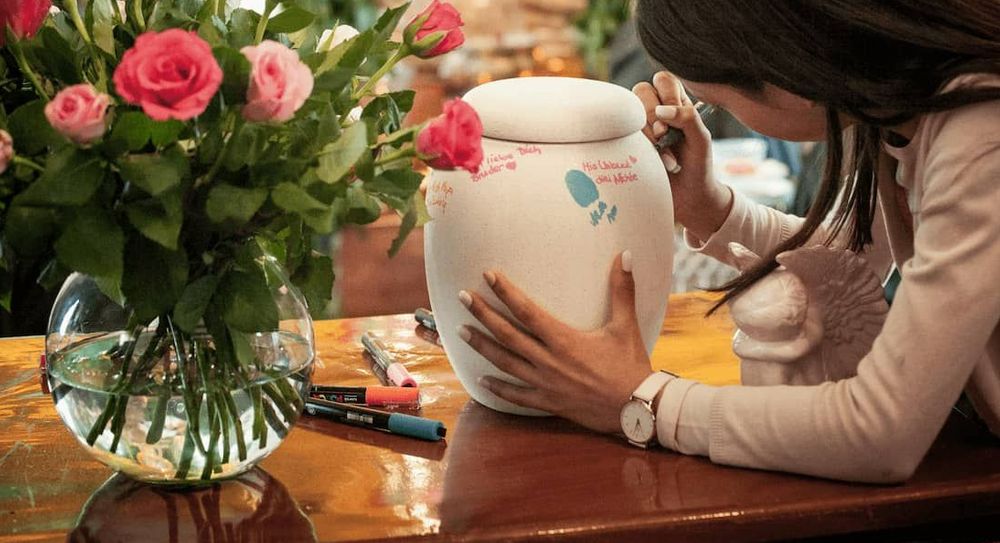How much does a burial cost in the UK?
In 2023, the average cost of a burial in the UK was £5,077 (SunLife 2024). This includes the cost of a funeral, plus the burial plot and interment fees. It doesn’t include things like the venue, flowers or a headstone.
Several things affect the overall price of a burial. These are:
- The cost of a burial plot
- The coffin
- The headstone
The cost of these things can vary a lot depending on where you live and the kind of burial you want.
In this article, we break down these costs and look at ways to save money on a burial.
What’s the average cost of a burial plot in the UK?
A burial plot (grave plot) is a piece of land where a person is buried. Most burial plots are in churchyards, cemeteries and woodland burial sites.
How much does a burial plot cost in the UK? The price you pay is affected by several things, including where you live and the location of the plot.
Burial plots in London, for instance, are much more expensive than in some other areas of the country. And you’ll usually pay more for a plot in a private graveyard than a council cemetery.
Another big factor is whether the person who has died wanted to be buried locally. It’s common for council cemeteries to charge local residents a much lower fee than people who didn’t live in the area.
The lowest burial plot costs we found in the UK were for Belfast City Council, where they start from £305 for residents. In other areas of the UK, costs are much higher. In Coventry, for example, burial plot costs start from £2567.50 for residents. In the London Borough of Hammersmith and Fulham, burial plot prices start from £3055 for residents.
Burial plots for children (under 18 years old) usually cost a lot less. Many councils offer them free of charge for local residents.
How does buying a burial plot work?
Burial plots are rarely actually sold. It’s more common to pay for an Exclusive Right of Burial. This means nobody else is allowed to be buried in the plot unless you give permission. Exclusive Right of Burial usually lasts between 50 and 100 years.
In this way, buying a burial plot is like paying for a leasehold on a house. You buy the right to use the land for a long time, but once the lease runs out it returns to the landowner – the cemetery.
When this happens, someone will have to decide whether to extend the lease. If they choose not to, the headstone will be removed and other people might be buried in the same grave.
What’s included in burial plot costs?
When you lease a burial plot, the Exclusive Right of Burial is always included. You also have to pay for interment, which means digging and refilling the grave. And the cemetery may charge a fee to look after the grave. This fee is often called a ‘grave maintenance fee’.
Interment and maintenance fees aren’t always included in burial plot costs. You’ll need to pay for the coffin and headstone separately, too.
How much does a coffin cost?
There are lots of different kinds of coffins. Some cost a lot more than others.
If you don’t want a lot of fuss, you could choose a cardboard or wicker coffin. These designs are inexpensive and can look elegant yet simple. A cardboard coffin costs about £280, while a wicker coffin costs around £500.
For a traditional wooden coffin, you can expect to pay anything from £600 to £2000 or more. It depends on the type of wood and the style you want. You’ll pay more for elaborately carved decorations, metal handles and other finishing touches.
Learn more about choosing a coffin.
How much does a burial headstone cost?
Headstones are quite expensive.
In 2023, the average cost of a memorial was £1,037 (SunLife 2024). A memorial means a headstone or another type of monument that pays tribute to a person who has died.
The cost of a headstone depends on the design and material you choose, as well as its finish. Generally speaking, the bigger and more elaborate the headstone, the more you’ll pay. For instance, a simple burial plaque costs less than a large, kerbed headstone.
You also need to consider engraving fees to add a message onto the headstone. Many memorial masons charge by the letter, so longer messages can be quite a lot more expensive.
Read more about typical headstone costs.
How much is a double burial plot in the UK?
Sometimes, people choose to be buried together in the same grave. This requires a double-depth burial plot. A double-depth plot is deep enough for 2 coffins to be safely buried on top of one another.
How much does it cost to be buried in a double-depth plot? It depends on the burial ground you choose, but most charge a little more for interment in a double-depth grave. Some also charge extra for Exclusive Right of Burial.
Flintshire County Council, for instance, charges residents £300 for Exclusive Right of Burial in any kind of traditional grave. However, it charges £909 to dig the grave to double depth, compared to £826 for a single-depth plot.
If you live in South Staffordshire and you want a double-depth plot, you’ll have to pay more for interment and Exclusive Right of Burial. Here, it costs £7 more for Exclusive Right of Burial and £104 more for interment compared to a single-depth grave.
There are triple-depth plots too, which can hold 3 coffins. Typically, a triple-depth burial plot costs more than a single- or double-depth burial plot.
How much does it cost to reopen a grave in the UK?
If you’ve chosen a double-depth burial plot, the grave will have to be reopened in future so the second person can be buried.
As with other kinds of burial costs, fees for reopening graves vary depending on where you live and the burial ground you choose.
To give one example, Powys County Council charges residents the same price for the first and second interment (£1140). Slough Borough Council, meanwhile, charges £2040 for the first interment and £850 to reopen the grave.
Reopening a grave is not the same as exhumation. This is where the coffin is removed from the grave. Exhumation is rare.
How much is a burial plot for ashes in the UK?
After a cremation, you can choose to scatter the person’s ashes, keep them in an urn or bury them in a remembrance garden or cemetery.
The process works in much the same way as a traditional burial. You have to pay for a burial plot (Exclusive Right of Burial), a container for the ashes and a memorial – if you want one. You’ll also have to pay an interment fee.
Again, how much burial plots are depends on your location and choice of burial ground. In Slough, a council plot costs £780 for residents, plus £390 for interment (£1170 total). In Flintshire, meanwhile, it costs £119 to reserve a cremated remains plot and £240 for interment (£359 total).
Can you save money on a burial?
Yes. There are lots of ways to save on burial costs. Bear in mind that you might have to compromise on your funeral plans, though.
Weigh up the cost of cremation vs burial
Lots of people choose to be buried for religious or personal reasons. If the person who has died said they wanted to be buried, then you’ll probably want to honour their wish.
However, if cremation is an option that the person might have considered, you may want to consider it.
Why? Because cremation is almost always less expensive than burial. In 2023, the average cost for a funeral with a cremation was £3,795 (SunLife 2024). That’s more than £1000 cheaper than the average for a burial.
Pay for a burial plot in advance
The cost of burial plots is increasing, especially in urban areas. So if you’re planning your own funeral, you might want to pay for a burial plot now (known as ‘purchase in reserve’). This way, you could save your family from paying higher costs later on. But bear in mind that if you do buy a burial plot in advance, you’ll usually pay a reservation fee on top of the price of the plot.
Choose a simpler coffin or headstone
Ask yourself: is an expensive coffin or headstone really important to you? If you’re willing to choose something simpler, you could save a lot on burial costs.
And remember that you don’t have to pay for an elaborate headstone straight away. You could start with a simple grave marker and then replace it with a headstone when you can afford to.
Choose a council cemetery
Burial plots in council cemeteries tend to be cheaper than those in private burial grounds – so long as the person who has died lived locally. However, costs can vary a lot, so be sure to do your research.
Things can get more complicated if you have special religious needs. Depending on where you live, you may have to choose a private cemetery if you want the burial to follow the laws of your faith. For instance, some council cemeteries have separate areas for Muslim burials, while others don’t.
Consider a natural burial
A natural burial aims to be as eco-friendly as possible. In a natural burial, the person who has died is buried in a green space among wildflowers or trees.
Although these kinds of burial plots can be quite expensive, natural or woodland burial costs can work out cheaper than usual. This is because people must be buried in affordable, biodegradable coffins – and without elaborate headstones.
So if you like the idea of an affordable, eco-friendly funeral, a natural burial could be a good option. You can read more about natural burials here.
Consider a direct burial
A direct burial is a type of unattended funeral. This means the person who has died is buried without a funeral service. If the person is cremated instead, it’s known as a direct cremation.
Unattended funerals are becoming more popular. Between 2019 and 2023, the number of people choosing a direct cremation rose from 3% to 20% (SunLife 2024).
This is partly because unattended funerals are so affordable. A direct burial costs much less than a funeral with a service – and a direct cremation is even cheaper.
It might seem odd that there’s no formal ceremony. But remember that you’re free to say goodbye in your own way at a later date. Lots of people who choose a direct burial or cremation follow it up with a memorial service. This can be an informal ceremony where people share stories and celebrate the life of the person who has died.
Photo by The Good Funeral Guide on Unsplash.




